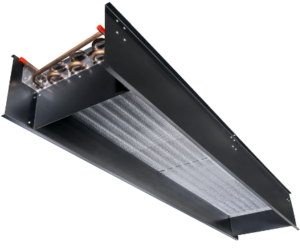In this blog, we’re going to be talking about the principles of active and passive chilled beam systems, as well as how they differ from each other and conventional VAV systems. We’ll end with a question often raised when engineers begin laying out a chilled beam system; how do you design your Outside Air Units and is it possible to control the humidity in a space with these systems?
What is a Chilled Beam?
You might be wondering what a chilled beam system is in the first place. Well, it is an HVAC system that applies chilled water as the sensible heat transfer medium local to each zone in a building instead of air. Why, water is a more dense heat transfer medium than air, so it requires less system horsepower to remove sensible heat from a building than air. By decoupling the total load (sensible + latent energy) and allowing a chilled water system to remove a building’s sensible load local to each zone, system efficiency is significantly increased. The airside component is designed to meet minimum ventilation air requirements as prescribed by ASHRAE Standard 62.1. 100% outside air (OSA) air handlers, otherwise known as dedicated outside air (DOAS) units also, when designed appropriately, control a building’s humidity levels. For our dry Southwestern climate region, using 100% outside air systems are a perfect solution for conditioning a building while controlling humidity.
Active or Passive? – What’s the Difference?
Active chilled beams are two plenum-tiered devices; outside air is ducted to the upper tier and a chilled/hot water coil is mounted in the lower tier. Active beams inject air at high velocity into a zone creating a mixed-air condition in a space; i.e. uniformity of temperature throughout the cubic volume of space. They are mechanical devices that require no fan, filter, or condensate pans.
Passive Chilled Beams

Passive chilled beams are supplied by a building’s chilled water loop mounted in the ceiling of a room. The air component is decoupled from a passive beam and supplied by a DOAS unit for the ventilation air. To drive as much sensible heat possible to the passive beam, a space is thermally stratified to maximize the air delta T at the beam. What moves air in a thermally stratified environment, convection; cold air falls, warm air rises. {Figure 5} Passive beam systems add a layer of efficiency compared to an active system as displacement ventilation supplies the required ventilation air at a higher temperature (~65F DB) allowing for economizer hours in Maricopa County to be doubled.

Active Chilled Beams

Active chilled beams are ducted two-tiered plenum devices that inject air at high velocity in a room to create a mixed air environment. 100% outside air is injected into the top plenum and injects air to the lower plenum opposite the sides of a cooling coil resulting in a negative pressure zone above the coil allowing room air to be induced into the beam coil section where sensible heat energy is absorbed. {Figure 9}

Chilled Beam Systems vs. Conventional VAV Systems
When faced with a new building project or renovation, decision-makers often have to overcome multiple obstacles. Some may be trying to achieve LEED certification; others may have space limitations where the option of a traditional VAV system would be difficult. Others may want to free up floor space or upgrade their HVAC systems, thereby lowering energy consumption and operating costs and, in today’s post-pandemic period, create healthier environments. In many cases, chilled beams are often the best solution for these needs.
Compared to a conventional VAV system, chilled beams require 50-75% less primary airflow. Because Chilled Beam systems use water to transfer sensible heat rather than air, they are able to achieve greater efficiency. This is because water has 4.23 times greater specific heat capacity than air thereby reducing the amount of motor horsepower required to remove heat energy from a building.
Chilled Beams are ideal for buildings and zones with medium to high sensible cooling and heating loads and low to medium latent loads. Higher latent loads can be controlled, however, by reducing the ventilation air dew point enough to offset the latent gain. Common applications include offices, laboratories, university buildings, healthcare, and schools – both new construction and renovations.
In addition to being more efficient, Chilled Beams are also easier to install than traditional systems. Because they do not require large amounts of ventilation, they can be installed in areas where there is limited space or where installing ventilation would be difficult. Chilled Beams are also an excellent choice for retrofitting older buildings with new systems. They can be installed in an existing ceiling without disturbing the structure, which makes them well-suited for historic or landmark buildings that are not easily modified,
Outside Air
What are the proper design configurations for DOAS units and the importance of supply air dew point to provide building humidity control? Thinking outside the box: Is 44F chilled water required for humidity control? Challenge convention to optimize central plant performance and reduce operating costs.
Join our webinar on Wednesday, September 28th, 2022 at 11am PDT to learn more about Chilled Beam, Outside Air Design, and challenging conventional thinking!
Register here: http://events.constantcontact.com/register/event?llr=6logklvab&oeidk=a07ejalsjlh32e2bdce